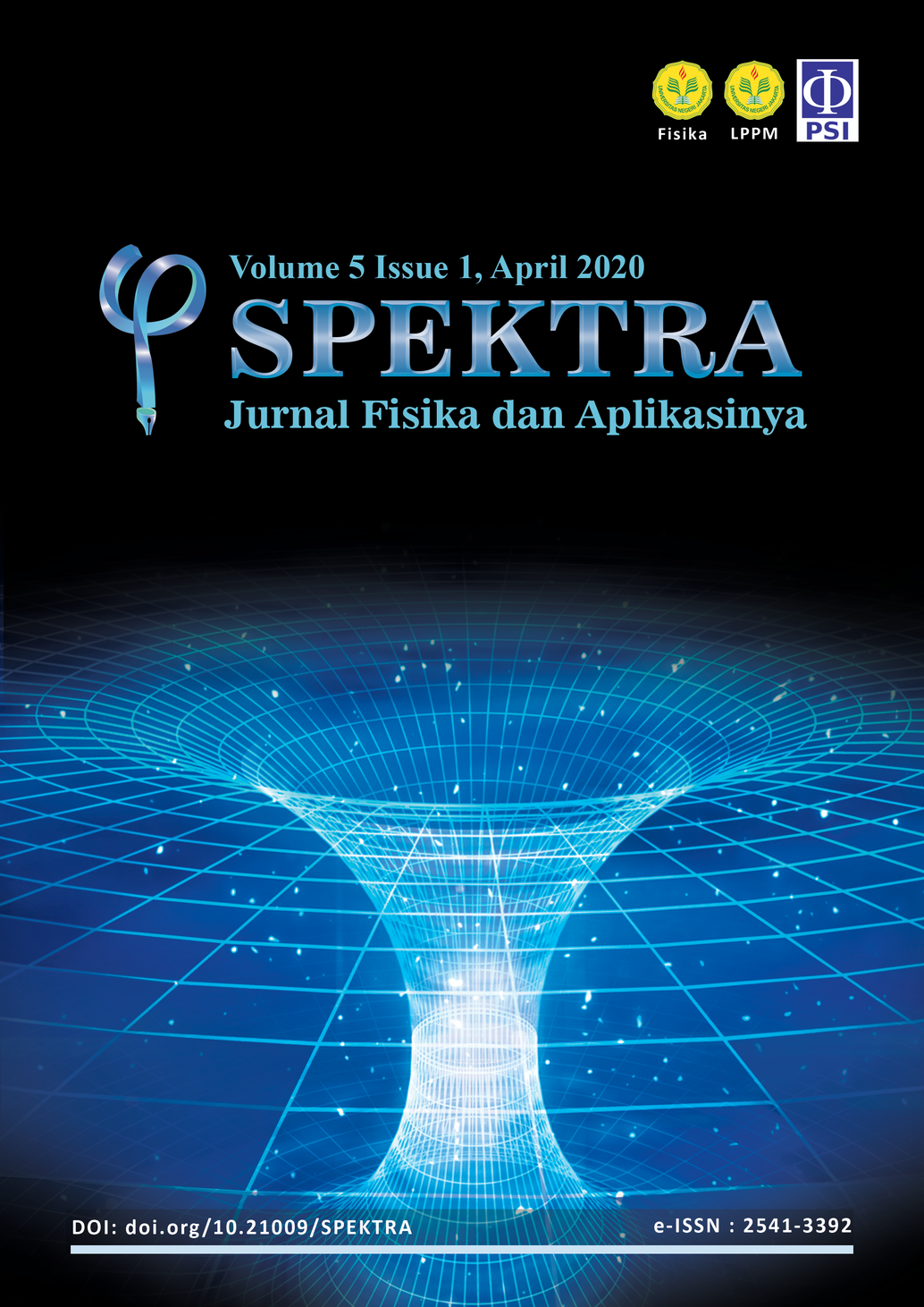THE DETERMINATION OF BARIUM STRONTIUM TITANATE THIN FILM BAND GAP ENERGY Ba0,15Sr0,85TiO3 USING ULTRAVIOLET-VISIBLE SPECTROSCOPY
DOI:
https://doi.org/10.21009/SPEKTRA.051.02Keywords:
the thin layer of barium strontium titanate, sol-gel method, optical characterization, the energy bandgapAbstract
A thin layer of Barium Strontium Titanate Ba0.15Sr0.85TiO3 (BST) was developed on a glass substrate using a sol-gel method with annealing temperatures and spin coating process at 3500 rpm for 30 seconds. The annealing temperature varied from 600oC, 650oC, and 700oC. Characterization of optical properties was developed using UV-Vis spectroscopy to determine the energy bandgap. The values of the BST thin layer energy band at the annealing temperature were 3.55 eV, 3.32 eV, and 3.10 eV, respectively. The results indicate that the BST thin film was a semiconductor material.
References
[2] H. Sharma et al., “Surface, phase transition and impedance studies of Zr- mutated BaTiO 3 lead-free thin films,” Results in Physics, 2019, vol. 13, 102190.
[3] A.S. Everhardt et al., “Temperature-independent giant dielectric response in transitional BaTiO3 thin films,” Applied Physics Reviews, 2020, vol. 7, no. 1.
[4] R.A. Malik et al., “Thermal-stability of electric field-induced strain and energy storage density in Nb-doped BNKT-ST piezoceramics,” Journal of the European Ceramic Society, 2018, vol. 38, no. 6.
[5] M. Zhou et al., “Novel BaTiO3-based lead-free ceramic capacitors featuring high energy storage density, high power density, and excellent stability,” J. Mater. Chem. C, 2018, vol. 6, no. 31.
[6] M. Zhou et al., “High energy storage properties of (Ni1/3Nb2/3)4+complex-ion modified (Ba0.85Ca0.15)(Zr0.10Ti0.90)O3 ceramics,” Mater. Res. Bull., 2017, vol. 98.
[7] R. Dewi, “Formation and characterization of typical films Ba0.2Sr0.8TiO3 using XRD, FESEM and Spectroscopy impedance,” J. Phys. Conf. Ser., 2018, vol. 1120, no. 1.
[8] B. I. Edmondson et al., “Epitaxial, electro-optically active barium titanate thin films on silicon by chemical solution deposition,” J. Am. Ceram. Soc., 2020, vol. 103, no. 2.
[9] R. Dewi et al., “Characterization of optical properties of thin-film Ba1-xSrxTiO3 (x = 0,70; x= 0,75; and x=0,80) using ultraviolet-visible spectroscopy,” AIP Conf. Proc., 2019, vol. 2169.
[10] N. A. Bakar et al., “Physical, electrical and optical characterizations of Ba0.5Sr0.5TiO3 (BST) thin films,” 2ND Int. Conf. Appl. PHOTONICS Electron, Jan. 2019, vol. 2203.
[11] V. Kavitha et al., “Optical and structural properties of tungsten-doped barium strontium titanate,” Mater. Today Proc., 2019.
[12] C. Gautam et al., “Synthesis, optical and solid NMR studies of strontium titanate borosilicate glasses doped with TeO2,” Results Phys., 2020, vol. 16.
[13] S. Y. Lou et al., “(1 1 0) – textured BaSn0.15Ti0.85O3/ Ba0.6Sr0.4TiO3/ BaZr0.2Ti0.8O3 multilayerswith enhanced tunable performance,” J. Alloys Compd., Dec. 2019, vol. 781.
[14] W. H. Lee et al., “Structural and dielectric properties of B2O3/ Li2O-added Ba0.6Sr0.4TiO3 multilayer ceramics for tunable devices,” Ceram. Int., 2020, vol. 46, no. 3.
[15] S. J. Gao, “Dielectric properties and synthesis of magnesium doped strontium titanate with annona squamosa-like,” Results Phys., no. Dec. 2019, vol. 16.
[16] T. Zaman et al., “Mono and co-substitution of Sr 2+ and Ca 2+ on the structural, electrical, & optical properties of barium titanate ceramics,” Ceram. Int., 2019, vol. 45, no. 8.
Downloads
Published
How to Cite
Issue
Section
License
SPEKTRA: Jurnal Fisika dan Aplikasinya allow the author(s) to hold the copyright without restrictions and allow the author(s) to retain publishing rights without restrictions. SPEKTRA: Jurnal Fisika dan Aplikasinya CC-BY or an equivalent license as the optimal license for the publication, distribution, use, and reuse of scholarly work. In developing strategy and setting priorities, SPEKTRA: Jurnal Fisika dan Aplikasinya recognize that free access is better than priced access, libre access is better than free access, and libre under CC-BY or the equivalent is better than libre under more restrictive open licenses. We should achieve what we can when we can. We should not delay achieving free in order to achieve libre, and we should not stop with free when we can achieve libre.
 SPEKTRA: Jurnal Fisika dan Aplikasinya is licensed under a Creative Commons Attribution 4.0 International License.
SPEKTRA: Jurnal Fisika dan Aplikasinya is licensed under a Creative Commons Attribution 4.0 International License.
You are free to:
Share - copy and redistribute the material in any medium or format
Adapt - remix, transform, and build upon the material for any purpose, even commercially.
The licensor cannot revoke these freedoms as long as you follow the license terms.

 E-ISSN 2541-3392
E-ISSN 2541-3392  Focus & Scope
Focus & Scope  Editorial Team
Editorial Team  Reviewer Team
Reviewer Team  Author Guidelines
Author Guidelines  Article Template
Article Template  Author Fee
Author Fee  Publication Ethics
Publication Ethics  Plagiarism Policy
Plagiarism Policy  Open Access Policy
Open Access Policy  Peer Review Process
Peer Review Process  Retraction & Correction
Retraction & Correction  Licensing & Copyright
Licensing & Copyright  Archiving & Repository
Archiving & Repository  Contact
Contact  Mendeley
Mendeley 

